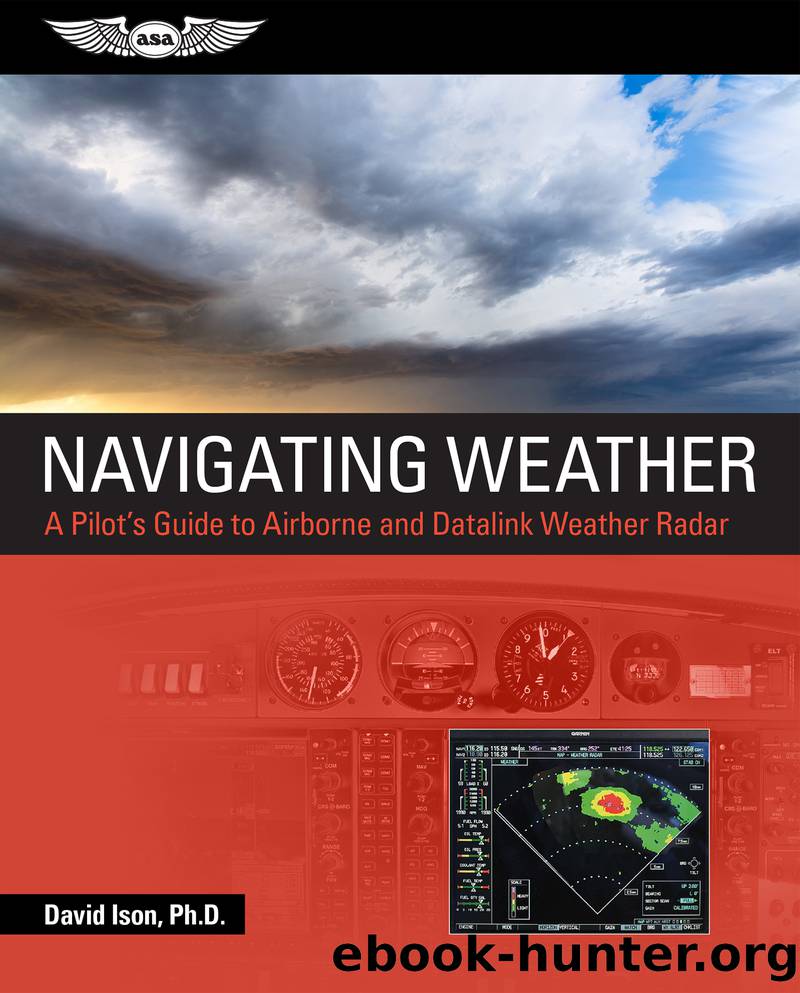Navigating Weather by Ison David;

Author:Ison, David; [David Ison, Ph.D.]
Language: eng
Format: epub
Publisher: Aviation Supplies & Academics, Inc.
Published: 2021-10-24T15:02:29+00:00
Tilt Pitfalls
Unfortunately, there are some common but improper tilt management techniques that can easily lead to dangerous weather encounters. One such pitfall is what I call wrong scanning. This is when a pilot aims the beam in the wrong place (or a less-than-ideal place). A typical example of this is when the beam is not pointed at the highest reflectivity areaâthat intermediate portion of a storm near or below the freezing level. As a result, the beam is not filled, and therefore, the returns will be understated on the PPI. This obviously could lead to inadvertent penetration of nasty weather. Two sub-types of wrong scanning are under-scanning and over-scanning. Under-scanning refers to when the radar beam is pointed down excessively and thus undershoots weather beyond the beam (see Figure 3-30). Obviously, this could lead to an aircraft getting dangerously close to a storm, perhaps so close it would be unable to avoid it once the beam finally started to paint the cell. Over-scanning refers to the case in which the tilt is set too high to detect the weather below the bottom of the beam (see Figure 3-31). This is most likely to occur at cruise, particularly at high altitudes. Even if a pilot has set the tilt correctly to detect distant weather, as the aircraft approaches a storm, the cell will slip beneath the bottom of the radar beam. This phenomenon is often seen on the PPI as a strong cell appearing to weaken as it gets closer to the aircraft, but in reality, the storm is filling less and less of the radar beam as the aircraft closes in on the storm. Another caution should be noted: rapidly building storms can sneak up from below the radar beam, catching crews off guard. What is the key takeaway message? Yes, I will repeat it: tilt needs to be actively manipulated to continually check to see what is going on below, at, and above the aircraftâs flight path.
Download
This site does not store any files on its server. We only index and link to content provided by other sites. Please contact the content providers to delete copyright contents if any and email us, we'll remove relevant links or contents immediately.
| Airport | Commercial |
| Helicopters | History |
| Pictorial | Piloting & Flight Instruction |
| Repair & Maintenance |
Small Unmanned Fixed-wing Aircraft Design by Andrew J. Keane Andras Sobester James P. Scanlan & András Sóbester & James P. Scanlan(32589)
Navigation and Map Reading by K Andrew(4899)
Endurance: Shackleton's Incredible Voyage by Alfred Lansing(4531)
And the Band Played On by Randy Shilts(2027)
Wild Ride by Adam Lashinsky(1876)
The Box by Marc Levinson(1868)
Top 10 Prague (EYEWITNESS TOP 10 TRAVEL GUIDES) by DK(1856)
The Race for Hitler's X-Planes: Britain's 1945 Mission to Capture Secret Luftwaffe Technology by John Christopher(1744)
The One Percenter Encyclopedia by Bill Hayes(1725)
Trans-Siberian Railway by Lonely Planet(1638)
Girls Auto Clinic Glove Box Guide by Patrice Banks(1625)
Looking for a Ship by John McPhee(1581)
Batavia's Graveyard by Mike Dash(1559)
TWA 800 by Jack Cashill(1537)
Fighting Hitler's Jets: The Extraordinary Story of the American Airmen Who Beat the Luftwaffe and Defeated Nazi Germany by Robert F. Dorr(1520)
Troubleshooting and Repair of Diesel Engines by Paul Dempsey(1504)
Good with Words by Patrick Barry(1502)
Ticket to Ride by Tom Chesshyre(1494)
Bligh by Rob Mundle(1493)
